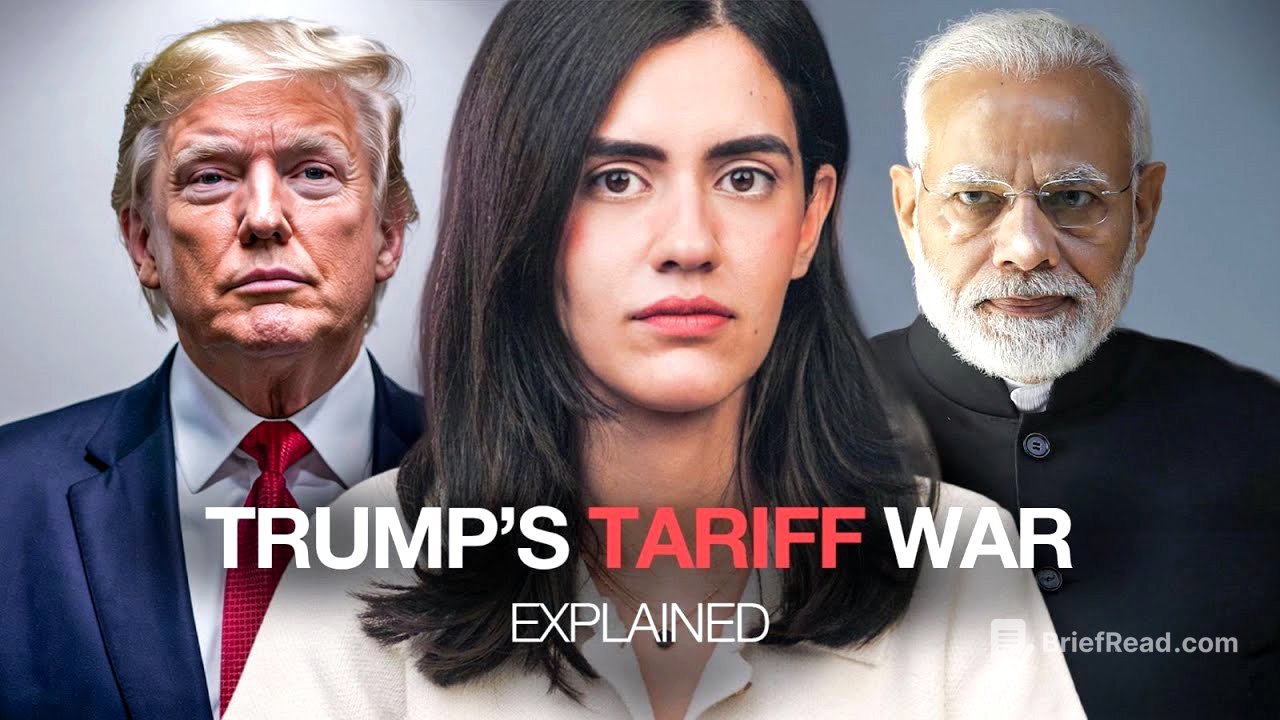TLDR;
This video discusses the impact of US tariffs, particularly those imposed by Donald Trump, on India and the global economy. It explains the history of tariffs, their potential benefits and drawbacks, and how they affect trade relations between countries. The video highlights the challenges faced by Indian businesses due to these tariffs and the broader issue of China's dumping practices.
- Tariffs, historically used by countries like the US and China to protect growing industries, can also lead to trade wars and economic downturns.
- Trump's tariff policies, including those targeting India, have caused economic disruptions and increased costs for consumers.
- India faces a complex situation, balancing its reliance on Chinese imports with the need to protect local businesses from dumping practices, while also navigating the impact of US trade policies.
The Impact of US Tariffs on India [0:01]
The video starts by highlighting the concerns of Indian business owners regarding the impact of US tariffs, particularly those initiated by Donald Trump. These tariffs are causing export orders to be put on hold and making it difficult for local manufacturers to compete with Chinese products. Trump's actions, including calling India the "biggest abuser of tariffs" and imposing tariffs on Indian goods, have led to significant financial losses in the stock market and threaten India's GDP growth.
The History of Tariffs [2:27]
The video explains that tariffs are taxes on goods imported from other countries. In the 18th century, America used tariffs to protect its nascent industries from British competition. By imposing a 5% tax on imported goods in 1789, America encouraged local production and generated revenue. This strategy was also used by countries like the Soviet Union, China, and India to foster domestic growth. Economists believe tariffs can be beneficial when a country's industry is developing, helping local manufacturers become strong enough to compete internationally.
The Great Depression and Free Trade [7:02]
In 1930, during the Great Depression, the US passed the Smoot-Hawley Tariff Act, imposing high tariffs on imported goods. However, this led to retaliation from other countries, causing a trade war and a significant decrease in global trade. This experience taught the US and other countries the importance of free trade policies and reducing trade barriers.
The Generalized System of Preferences (GSP) [8:29]
The Trade Act of 1974 introduced the Generalized System of Preferences (GSP), allowing developing countries like India to export goods to the US without tariffs. This act significantly boosted the Indian economy, opening up export opportunities for industries like textiles, gems, jewelry, and leather. While not all export items received GSP benefits, it still resulted in lower tariffs on Indian products compared to those on US imports. Trump's decision to remove India's GSP status during his first term had a limited impact, as only 12% of Indian exports were under the GSP rule.
The Impact of Tariffs on US Consumers [10:50]
Trump's tariffs, intended to make America great again, have negatively impacted US consumers. For example, tariffs on washing machines increased the cost of both imported and locally produced machines. A report showed that consumers paid more due to these tariffs than the government collected. While some jobs were created, the price increases cost consumers $1.5 billion, meaning Americans paid a hefty sum per job created. Studies also indicated that Trump's trade war led to a net loss of jobs in America.
Targeted vs. Broad Tariffs [12:23]
Tariffs can be used to reduce dependency on other countries and address trade imbalances. Economists categorize tariffs into targeted and broad types. Targeted tariffs apply to specific goods from a particular industry, aiming to reduce dependency and encourage local manufacturing. Broad tariffs, like the 25% tariff on steel and aluminum imports, apply to various products from a specific country or all countries. Broad tariffs are less effective in fixing trade deficits due to exchange rate adjustments, which can cancel out much of the intended effect.
The Impact on Indian Businesses [16:31]
Even before the trade war between America and China, India faced economic challenges due to China's practice of dumping goods, which involves exporting products at prices below production cost to undermine local competition. This "China shock" has affected industries like steel, metals, plastics, chemicals, textiles, and electronics, forcing many Indian businesses to struggle or shut down. While retaliatory tariffs on Chinese imports might seem like a solution, India's manufacturing sectors rely heavily on raw materials and components from China. As the US imposes higher tariffs on Chinese products, China intensifies its dumping strategies in countries like India, creating a complex situation for Indian businesses.
Navigating the Complex Geopolitical Landscape [18:39]
Understanding these global dynamics is crucial for Indian entrepreneurs and professionals. Tariffs create instability that impacts consumer confidence, investor sentiment, and hiring decisions. India faces the challenge of balancing its economic ties with China and navigating America's unpredictable tariff policies. This requires careful strategy and awareness, as these issues reshape the economic environment. The smartest individuals stay ahead by recognizing these patterns early on, understanding that tariffs, trade wars, and geopolitical shifts are signals of the future.
